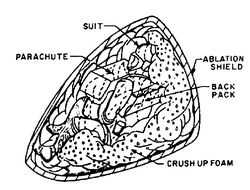59:
48:
37:
144:. Finally, once the astronaut had descended to 30,000 ft (9.1 km) where the air was sufficiently dense, the parachute would automatically deploy and slow the astronaut's fall to 17 mph (7.6 m/s). The foam heat shield would serve a final role as cushioning when the astronaut touched down and as a flotation device should they land on water. The radio beacon would guide rescuers.
163:. However, the MOOSE system was nonetheless always intended as an extreme emergency measure when no other option for returning an astronaut to Earth existed; falling from orbit protected by nothing more than a spacesuit and a bag of foam was unlikely to ever become a particularly safe—or enticing—maneuver.
136:, with the astronaut embedded in its base facing the apex of the cone. The rocket pack would protrude from the bag and be used to slow the astronaut's orbital speed enough so that he would reenter
102:
in the early 1960s. The system was quite compact, weighing 200 lb (91 kg) and fitting inside a suitcase-sized container. It consisted of a small twin-nozzle
151:
mission, inflating a foam-filled bag with a human subject embedded inside, and test-dropping dummies and a human subject in MOOSE foam shields short distances.
147:
General
Electric performed preliminary testing on some of the components of the MOOSE system, including flying samples of heat shield material on a
159:'s historic freefall from a balloon at 103,000 ft (31,000 m) in August 1960 also helped demonstrate the feasibility of such extreme
300:
252:
107:
346:
325:
341:
320:
270:
239:
235:
189:
174:
expressed an interest in the MOOSE system, and so by the end of the 1960s the program had been quietly shelved.
215:
28:
137:
283:
195:
111:
58:
47:
36:
257:
133:
99:
24:
148:
171:
152:
132:, climb inside the plastic bag, and then fill it with foam. The bag had the shape of a
335:
156:
115:
160:
141:
326:
Analysis and design of space vehicle flight control systems. Volume 16 - Abort
129:
122:
91:
83:
110:
bag 6 ft (1.8 m) long with a flexible 0.25 in (6.4 mm)
90:, was a proposed emergency "bail-out" system capable of bringing a single
183:
271:
Gravity: Forgotten Space Escape Pod Could Bring Sandra
Bullock Home Safe
140:, and the foam-filled bag would act as insulation during the subsequent
75:
103:
95:
20:
198:– Proposed system to rescue Apollo astronauts from lunar surface
167:
118:
230:
228:
64:
Analysis and Design of Space
Vehicle Flight Control Systems
53:
Analysis and Design of Space
Vehicle Flight Control Systems
42:
Analysis and Design of Space
Vehicle Flight Control Systems
114:
on the back, two pressurized canisters to fill it with
216:
MOOSE means Manned
Orbital Operations Safety Equipment
98:
to the planet's surface. The design was proposed by
273:, GE.com, March 01, 2014. Retrieved 9 June 2021.
253:The Wearable Reentry Spacecraft Of Yesteryear
106:motor sufficient to deorbit the astronaut, a
8:
128:The astronaut would leave the vehicle in a
321:Encyclopedia Astronautica article on MOOSE
88:Manned Orbital Operations Safety Equipment
186:– Inflatable cone-shaped reentry vehicle.
57:
46:
35:
208:
307:, 29 July 2006. Retrieved 9 June 2021.
290:, Jan. 8, 2015. Retrieved 9 June 2021.
125:, radio equipment and a survival kit.
7:
284:How to survive a spaceship disaster
251:Amy Shira Teitel (Oct. 12, 2017). "
192:– Inflatable ball-shaped space suit
86:to the more professional-sounding
14:
16:Personal Space Ejection Mechanism
1:
363:
18:
240:Encyclopedia Astronautica
190:Personal Rescue Enclosure
261:. Retrieved 9 June 2021.
242:. Retrieved 9 June 2021.
80:Man Out Of Space Easiest
23:. For the software, see
94:safely down from Earth
222:Retrieved 9 June 2021.
66:
55:
44:
29:Moose (disambiguation)
27:. For other uses, see
61:
50:
39:
196:Lunar Escape Systems
112:ablative heat shield
19:For the animal, see
347:Proposed spacecraft
138:Earth's atmosphere
67:
56:
45:
258:Discover Magazine
354:
342:Space technology
308:
297:
291:
280:
274:
268:
262:
249:
243:
232:
223:
213:
100:General Electric
74:, originally an
25:MOOSE (software)
362:
361:
357:
356:
355:
353:
352:
351:
332:
331:
317:
312:
311:
298:
294:
281:
277:
269:
265:
250:
246:
233:
226:
214:
210:
205:
180:
69:
68:
32:
17:
12:
11:
5:
360:
358:
350:
349:
344:
334:
333:
330:
329:
323:
316:
315:External links
313:
310:
309:
292:
275:
263:
244:
224:
207:
206:
204:
201:
200:
199:
193:
187:
179:
176:
172:U.S. Air Force
153:U.S. Air Force
62:Fig. 112 from
51:Fig. 111 from
40:Fig. 110 from
34:
33:
15:
13:
10:
9:
6:
4:
3:
2:
359:
348:
345:
343:
340:
339:
337:
327:
324:
322:
319:
318:
314:
306:
305:New Scientist
302:
296:
293:
289:
285:
279:
276:
272:
267:
264:
260:
259:
254:
248:
245:
241:
237:
231:
229:
225:
221:
220:All Acronyms.
217:
212:
209:
202:
197:
194:
191:
188:
185:
182:
181:
177:
175:
173:
169:
164:
162:
158:
157:Joe Kittinger
154:
150:
145:
143:
139:
135:
131:
126:
124:
120:
117:
113:
109:
105:
101:
97:
93:
89:
85:
84:later changed
81:
77:
73:
65:
60:
54:
49:
43:
38:
30:
26:
22:
328:see page 145
304:
301:Free Falling
295:
287:
278:
266:
256:
247:
219:
211:
165:
146:
127:
116:polyurethane
87:
79:
71:
70:
63:
52:
41:
161:parachuting
142:aerobraking
336:Categories
203:References
134:blunt cone
130:space suit
123:parachute
92:astronaut
288:The Week
184:Paracone
178:See also
170:nor the
166:Neither
108:PET film
149:Mercury
76:acronym
155:Capt.
104:rocket
236:MOOSE
96:orbit
72:MOOSE
21:Moose
168:NASA
121:, a
119:foam
82:but
78:for
303:",
286:",
255:",
238:",
338::
227:^
218:,
299:"
282:"
234:"
31:.
Text is available under the Creative Commons Attribution-ShareAlike License. Additional terms may apply.


